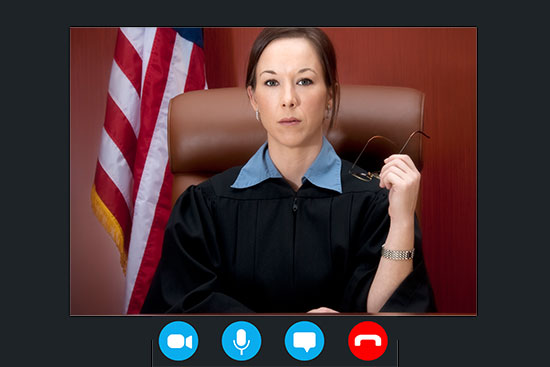
Aug. 5, 2020 – When disputed issues cannot be resolved between parties, one solution is a bench trial. A bench trial is, by contrast to trial by jury, a trial to the court in which the judge functions as the fact-finder.
Trial to the court can be a more focused and efficient way of dispute resolution. In this new age of pandemic functioning where physical distance is key to suppressing a contagious illness, litigants and courts have turned to technology to fill the void and reduce backlog until the hopeful return to unfettered in-person hearings.
While in-person hearings are potentially inadvisable, virtual bench trials are opening a new avenue to practice and refine your trial skills.
Virtual Appearances
That being said, virtual appearances during the life of a case are neither new, nor novel. Hearings conducted by telephone are routine in many civil appearances, especially when testimony or presentation of evidence is not anticipated.
 Jennifer Williams (Marquette 2007) is deputy city attorney for Racine and teaches an undergraduate course in human trafficking. Prior to her current role, she spent close to ten years as a Milwaukee County prosecutor trying bench and jury trials and, prior to that, participated in a weeks-long hearing on damages in The Hague, Netherlands, concerning a multibillion dollar international law claim by Eritrea against Ethiopia.
Jennifer Williams (Marquette 2007) is deputy city attorney for Racine and teaches an undergraduate course in human trafficking. Prior to her current role, she spent close to ten years as a Milwaukee County prosecutor trying bench and jury trials and, prior to that, participated in a weeks-long hearing on damages in The Hague, Netherlands, concerning a multibillion dollar international law claim by Eritrea against Ethiopia.
Appearances by telephone or videoconference save money on travel costs for attorneys, and generally promote efficiency.
In Milwaukee County, Local Rule 3.27 allows a court to assign the responsibility and cost for arranging teleconferences to one of the parties for non-evidentiary matters that are not too complex or unmanageable.
Local Rule 3.28 has long allowed for telephone and video conference testimony in evidentiary hearing for civil matters upon satisfaction of a few requirements: a day’s notice for the request; a court finding that suitable equipment is available to enable making a sufficient record; and either the parties agree, or the court grants the request after hearing any objections.
Alternatively, Wisconsin Statute Section 885.43-44 outline the procedures for introducing previously videotaped testimony of witnesses at trial, and is a helpful and cost-efficient way of presenting expert testimony.
Outside civil proceedings, virtual appearances are routine. Some custodial criminal defendants appear virtually by video for initial appearances to set bail.
Under Wis. Stat. § 908.08, pre-recorded interviews of certain child victims are introduced as direct testimony for the sake of limiting the traumatic impact of the jury trial experience on children.
Courts in Wisconsin have been forced by the ongoing coronavirus pandemic to utilize creative and unique ways to comply with social distancing recommendations both to prevent the spread of contagion, and also to protect court staff and litigants from exposure. As a result, cases are now being tried virtually in an attempt to recreate a courtroom experience.
Virtual courtrooms create a new and different set of considerations for attorneys. Knowing your tech platform, being even more prepared than usual and adopting a flexible approach in the moment are the keys to a successful virtual bench trial.
By “virtual trial,” I mean nothing to suggest that the process and outcomes are in any way less legitimate than the old fashioned bench trial experience.
That said, there are unique considerations for proving or defending your case by video. Knowing some of the pitfalls and opportunities in advance can help you and your client have a less stressful experience, and enable the court to function efficiently under new, often undesirable circumstances.
Presentation
As lawyers, preparation for trial is the key to your case, and far more important than the mythical “Perry Mason moment.” In law school, my favorite professor once told us, “I may not be the smartest guy in the room, but I will always be the most prepared.”
That sentiment has never served me better than in the context of a video conferenced bench trial. While many things may be out of your control once you commence presentation of evidence, relying on technology during a trial can be overwhelming.
Test sound and video on your computer or device well in advance. Make sure your background is neutral, professional and not distracting. Consider every possible detail well in advance, from the technology capabilities of your witnesses, to the cadence, and tempo of your questions.
At times, you may be at the mercy of someone else’s poor or uncooperative internet connection. It is absolutely essential to ensure that everyone can hear you and your witness. One solution for this is to wear ear buds or headphones to reduce background noise even if you are alone in a room. Use the mute feature when you are not questioning a witness or making an argument.
Witnesses require even more preparation for a virtual trial. Provide them with their own packet of exhibits and the Notice of Hearing. It’s fair to do a trial run to make sure they can access the application and join the virtual courtroom easily using the information you provide them. Professional witnesses typically have the equipment and/or office, as well as the experience, to appear easily without much handholding.
Lay witnesses may present different challenges, so it’s essential to have a frank discussion with them about basics: how will they appear, using what device, seated in which room, and with what assurances their testimony will not be interrupted?
Witnesses, professional or lay, are often understandably nervous in advance of testimony. Going over each detail of the “who, what, where, when, why and how” will save you time and headache at the moment you call them as a witness.
Importantly, keep it simple! This new world of virtual court comes in an abnormally stressful time. Appearing virtually for the first time is not the ideal occasion to test your firm’s new TrialPad software, or use sophisticated applications like screen share for the first time. When presenting an exhibit, I use low budget, old fashioned techniques: I e-file my exhibits in advance, then courtesy call the witnesses, clerk and my opponent to ensure delivery, and also make sure they will have a hard copy available for the hearing. If they don’t have the capability, I print a packet of my exhibits for their use and deliver or mail well before the trial itself.
Reach out to opposing counsel or your pro se litigant as a courtesy, especially in this environment of new techniques. You can make your life and case easier if you have some gauge of their familiarity with technology and the process of using it to create a virtual courtroom. While you may have a hotly contested issue, trying a case virtually requires more cooperation between parties than ever.
Up Close & Personal
Memes on social media and pop culture poke fun at the phenomenon of a “Zoom shirt.” This joke implies that we are all taking advantage of our home settings while presenting a professional front. It also implies that one can take certain shortcuts in this new environment: a nice shirt for the visible Zoom screen share paired with the invisible-to-participants sweatpants.
While that may be tempting, a virtual bench trial is not the time to take shortcuts. While you may be comfortable at home, the virtual courtroom is now right inside your office or family room. Despite being in a relaxed setting, don’t lose sight of the fact that you are bringing an important formal professional procedure into a physical area of your life where distractions may impair your ability to proceed. Find a room with a locked door so colleagues, family or pets cannot interrupt. Clear out personal memorabilia so as not to distract the court or witnesses from your evidentiary purpose.
Also take great care to note that you are more face-to-face with the court than ever before. The typical formality of the courtroom with the judge sitting high on the bench and parties below at counsel table shielded us from each other, and sometimes unfavorable habits. With everyone on a screen, you have a better than ever vantage point to judge facial expressions and body language.
You may have a greater sensitivity to your witness’ nerves, or the judge’s impatience. Take advantage of this opportunity to better “read the room” and conform your presentation. That said, make sure you keep in mind that you are equally up close and personal. Hide your own expressions!
One trial trick is to take detailed and thorough notes. Not only does this focus my concentration at a high level to the testimony being presented, but I make my own real time record. It also saves you in a particularly contentious proceeding from betraying your attitude about your opponent’s case.
Being front and center on the judge’s laptop screen is the last place you want to be caught rolling your eyes at a piece of incredible testimony.
We’re In this Together
The last and most important sentiment is not my brainchild: “We are in this together.” Never has this been or will be more important to using technology to adapt the oldest and most important task of lawyering. Trial skills remain the same.
Greater attention and sensitivity to the challenges of modifying our time tested techniques of dispute resolution in trial will ensure the entire process adheres to its original purpose: a search for the truth.
